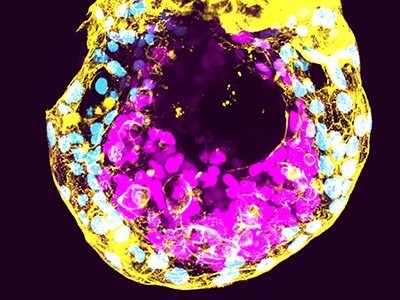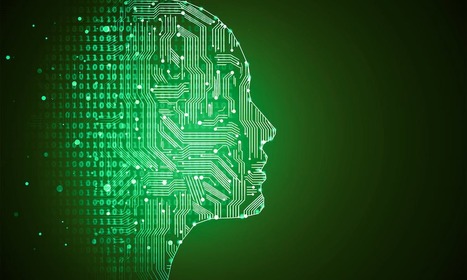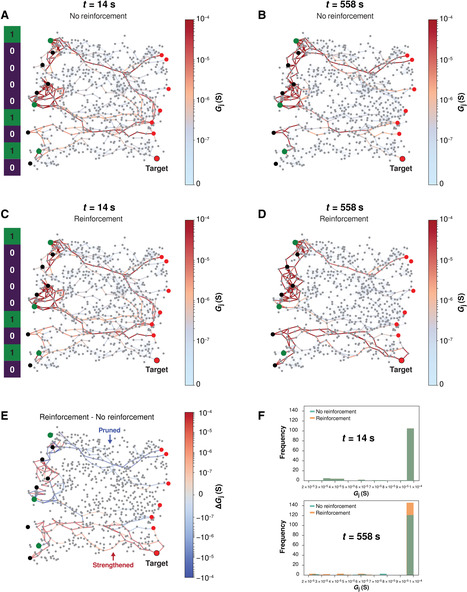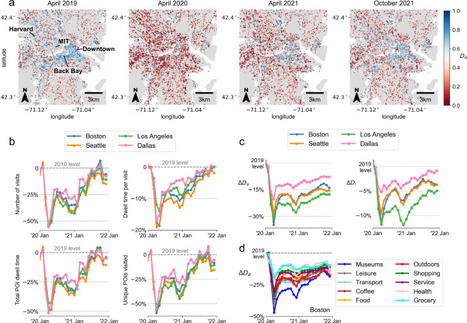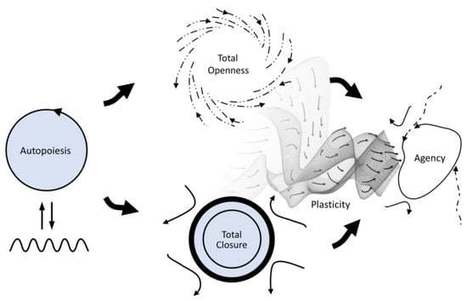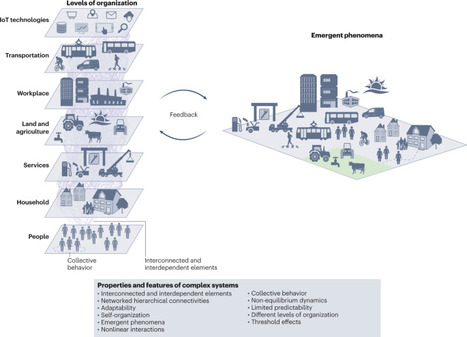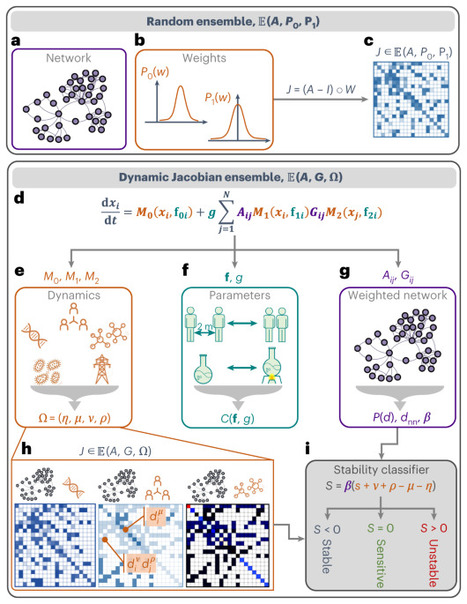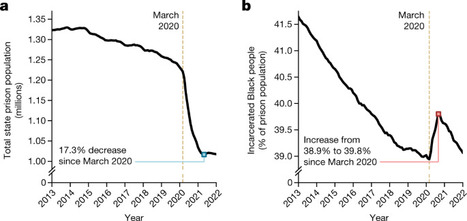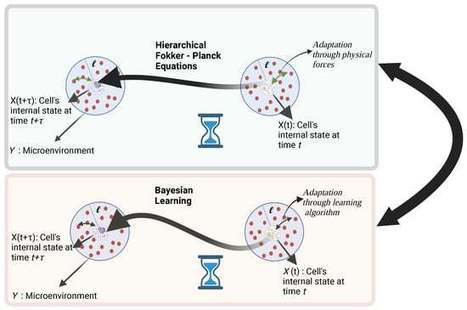 Your new post is loading...
 Your new post is loading...

|
Scooped by
Complexity Digest
May 12, 2023 5:55 PM
|
Nicholas W. Landry, Ilya Amburg, Mirah Shi, Sinan G. Aksoy
Many complex systems often contain interactions between more than two nodes, known as higher-order interactions, which can change the structure of these systems in significant ways. Researchers often assume that all interactions paint a consistent picture of a higher-order dataset's structure. In contrast, the connection patterns of individuals or entities in empirical systems are often stratified by interaction size. Ignoring this fact can aggregate connection patterns that exist only at certain scales of interaction. To isolate these scale-dependent patterns, we present an approach for analyzing higher-order datasets by filtering interactions by their size. We apply this framework to several empirical datasets from three domains to demonstrate that data practitioners can gain valuable information from this approach. Read the full article at: arxiv.org

|
Scooped by
Complexity Digest
May 12, 2023 2:02 PM
|
Philip Ball Concerned by the speed of research, policymakers are looking for alternative ways to establish rules on genome editing and other technologies. Read the full article at: www.nature.com

|
Scooped by
Complexity Digest
May 10, 2023 6:33 PM
|
Anil K. Seth Our minds haven’t evolved to deal with machines we believe have consciousness.
Read the full article at: nautil.us

|
Scooped by
Complexity Digest
May 9, 2023 1:42 PM
|
Austin M. Marcus and Hiroki Sayama Complexity Volume 2023 | Article ID 8852349 Collective motion models most often use self-propelled particles, which are known to produce organized spatial patterns via their collective interactions. However, there is less work considering the possible organized spatial patterns achievable by non-self-propelled particles (nondriven), i.e., those obeying energy and momentum conservation. Moreover, it is not known how the potential energy interaction between the particles affects the complexity of the patterns. To address this, in this paper, a collective motion model with a pairwise potential energy function that conserved the total energy and momentum of the particles was implemented. The potential energy function was derived by generalizing the Lennard–Jones potential to reduce to gravity-like and billiard-ball-like potentials at the extremes of its parameter range. The particle model was simulated under a number of parameterizations of this generalized potential, and the average complexity of the spatial pattern produced by each was computed. Complexity was measured by tracking the information needed to describe the particle system at different scales (the complexity profile). It was found that the spatial patterns of the particles were the most complex around a specific ratio in the parameters. This parameter ratio described a characteristic shape of the potential energy function that is capable of producing complex spatial patterns. It is suggested that the characteristic shape of the potential energy produces complex behavior by balancing the likelihood for particles to bond. Furthermore, these results demonstrate that complex spatial patterns are possible even in an isolated system. Read the full article at: www.hindawi.com

|
Scooped by
Complexity Digest
May 6, 2023 1:42 PM
|
Sai Krishna Katla, Chenyu Lin, Juan Pérez-Mercader Cell Reports Physical Science VOLUME 4, ISSUE 4, 101359, APRIL 19, 2023 • One-pot synthesis of simple non-biochemical, but functional, protocell populations
• Two populations emerge, differing only in that one has an advantage for reproduction
• The populations compete for food in a shared environment, with one dying out
• Simple protocells display Darwin’s “struggle for existence” without biochemistry Read the full article at: www.cell.com

|
Scooped by
Complexity Digest
May 5, 2023 1:58 PM
|
Mark Buchanan The results of influential studies are being used to monitor the world’s banking system amid continuing concerns over bank failures. Read the full article at: www.nature.com

|
Scooped by
Complexity Digest
May 4, 2023 3:31 PM
|
Alon Loeffler, Adrian Diaz-Alvarez, Ruomin Zhu, Natesh Ganesh, James M. Shine, Tomonobu Nakayama, Zdenka Kuncic SCIENCE ADVANCES 21 Apr 2023 Vol 9, Issue 1 Nanowire networks (NWNs) mimic the brain’s neurosynaptic connectivity and emergent dynamics. Consequently, NWNs may also emulate the synaptic processes that enable higher-order cognitive functions such as learning and memory. A quintessential cognitive task used to measure human working memory is the n-back task. In this study, task variations inspired by the n-back task are implemented in a NWN device, and external feedback is applied to emulate brain-like supervised and reinforcement learning. NWNs are found to retain information in working memory to at least n = 7 steps back, remarkably similar to the originally proposed “seven plus or minus two” rule for human subjects. Simulations elucidate how synapse-like NWN junction plasticity depends on previous synaptic modifications, analogous to “synaptic metaplasticity” in the brain, and how memory is consolidated via strengthening and pruning of synaptic conductance pathways. Read the full article at: www.science.org

|
Scooped by
Complexity Digest
May 3, 2023 11:32 AM
|
Fernanda Sánchez-Puig, Octavio Zapata, Omar K. Pineda, Gerardo Iñiguez, and Carlos Gershenson Front. Complex Syst., 03 May 2023 Criticality has been proposed as a mechanism for the emergence of complexity, life, and computation, as it exhibits a balance between order and chaos. In classic models of complex systems where structure and dynamics are considered homogeneous, criticality is restricted to phase transitions, leading either to robust (ordered) or fragile (chaotic) phases for most of the parameter space. Many real-world complex systems, however, are not homogeneous. Some elements change in time faster than others, with slower elements (usually the most relevant) providing robustness, and faster ones being adaptive. Structural patterns of connectivity are also typically heterogeneous, characterized by few elements with many interactions and most elements with only a few. Here we take a few traditionally homogeneous dynamical models and explore their heterogeneous versions, finding evidence that heterogeneity extends criticality. Thus, parameter fine-tuning is not necessary to reach a phase transition and obtain the benefits of (homogeneous) criticality. Simply adding heterogeneity can extend criticality, making the search/evolution of complex systems faster and more reliable. Our results add theoretical support for the ubiquitous presence of heterogeneity in physical, biological, social, and technological systems, as natural selection can exploit heterogeneity to evolve complexity “for free”. In artificial systems and biological design, heterogeneity may also be used to extend the parameter range that allows for criticality. Read the full article at: www.frontiersin.org

|
Scooped by
Complexity Digest
April 30, 2023 1:10 PM
|
The emerging field of synthetic morphology bends boundaries between natural and artificial life Read the full article at: www.scientificamerican.com

|
Scooped by
Complexity Digest
April 29, 2023 3:02 PM
|
Viktor Stojkoski, Philipp Koch & César A. Hidalgo
Communications Earth & Environment volume 4, Article number: 130 (2023) To achieve inclusive green growth, countries need to consider a multiplicity of economic, social, and environmental factors. These are often captured by metrics of economic complexity derived from the geography of trade, thus missing key information on innovative activities. To bridge this gap, we combine trade data with data on patent applications and research publications to build models that significantly and robustly improve the ability of economic complexity metrics to explain international variations in inclusive green growth. We show that measures of complexity built on trade and patent data combine to explain future economic growth and income inequality and that countries that score high in all three metrics tend to exhibit lower emission intensities. These findings illustrate how the geography of trade, technology, and research combine to explain inclusive green growth. Read the full article at: www.nature.com

|
Scooped by
Complexity Digest
April 28, 2023 5:05 PM
|
Takahiro Yabe, Bernardo García Bulle Bueno, Xiaowen Dong, Alex Pentland & Esteban Moro
Nature Communications volume 14, Article number: 2310 (2023) Diversity of physical encounters in urban environments is known to spur economic productivity while also fostering social capital. However, mobility restrictions during the pandemic have forced people to reduce urban encounters, raising questions about the social implications of behavioral changes. In this paper, we study how individual income diversity of urban encounters changed during the pandemic, using a large-scale, privacy-enhanced mobility dataset of more than one million anonymized mobile phone users in Boston, Dallas, Los Angeles, and Seattle, across three years spanning before and during the pandemic. We find that the diversity of urban encounters has substantially decreased (by 15% to 30%) during the pandemic and has persisted through late 2021, even though aggregated mobility metrics have recovered to pre-pandemic levels. Counterfactual analyses show that behavioral changes including lower willingness to explore new places further decreased the diversity of encounters in the long term. Our findings provide implications for managing the trade-off between the stringency of COVID-19 policies and the diversity of urban encounters as we move beyond the pandemic. Read the full article at: www.nature.com

|
Scooped by
Complexity Digest
April 28, 2023 1:04 PM
|
Arsham Ghavasieh and Manlio De Domenico
Phys. Rev. E 107, 044304 The network density matrix formalism allows for describing the dynamics of information on top of complex structures and it has been successfully used to analyze, e.g., a system's robustness, perturbations, coarse-graining multilayer networks, characterization of emergent network states, and performing multiscale analysis. However, this framework is usually limited to diffusion dynamics on undirected networks. Here, to overcome some limitations, we propose an approach to derive density matrices based on dynamical systems and information theory, which allows for encapsulating a much wider range of linear and nonlinear dynamics and richer classes of structure, such as directed and signed ones. We use our framework to study the response to local stochastic perturbations of synthetic and empirical networks, including neural systems consisting of excitatory and inhibitory links and gene-regulatory interactions. Our findings demonstrate that topological complexity does not necessarily lead to functional diversity, i.e., the complex and heterogeneous response to stimuli or perturbations. Instead, functional diversity is a genuine emergent property which cannot be deduced from the knowledge of topological features such as heterogeneity, modularity, the presence of asymmetries, and dynamical properties of a system. Read the full article at: link.aps.org

|
Scooped by
Complexity Digest
April 26, 2023 3:49 PM
|
González, A.; González, S.; Pereira, G.; Blanco, G. and von Lücken, C. (2023). In Proceedings of the 8th International Conference on Complexity, Future Information Systems and Risk - COMPLEXIS, ISBN 978-989-758-644-6; ISSN 2184-5034, SciTePress, pages 109-121. DOI: 10.5220/0012059400003485 International Economic Integration can be described as a process in which a group of countries seeks mutual benefits through mechanisms such as the elimination and/or reduction of trade, social, and political barriers between others. From an economic point of view, the importance of the integration of countries is fundamental for their development simply because most of them are part of some system of international economic integration. In this work, the issue of economic integration will not be discussed in depth but instead will oversee proposing some well-known metrics in the field of economic development that could be very useful as analysis and decision-making tools. in the process of regional economic integration. In this sense, this work proposes using concepts and metrics of Economic Complexity and Economic Fitness to identify combined productive capacities between countries that are part of an economic block, whether real or fictitious. The problem in understanding how econo mically integrate the countries is to identify the combined productive capacities that would exist if two or more countries that make up an economic block are considered as a single country. Experimental analyzes were carried out for a fictitious case, where a world with 10 countries and 15 products is presented; in addition, 3 economic blocks were defined, which were analyzed applying economic complexity and economic fitness metrics. The results obtained reflect the great importance of economic integration since, by establishing economic blocks, it is possible to capture more productive capacities by improving both the diversity of the economic block and the ubiquity of the products produced in it by addressing the productive capacities of the member countries. Read the full article at: www.scitepress.org
|

|
Scooped by
Complexity Digest
May 12, 2023 4:00 PM
|
Emanuela Del Dottore, Barbara Mazzolai Artificial Life Plants thrive in virtually all natural and human-adapted environments and are becoming popular models for developing robotics systems because of their strategies of morphological and behavioral adaptation. Such adaptation and high plasticity offer new approaches for designing, modeling, and controlling artificial systems acting in unstructured scenarios. At the same time, the development of artifacts based on their working principles reveals how plants promote innovative approaches for preservation and management plans and opens new applications for engineering-driven plant science. Environmentally mediated growth patterns (e.g., tropisms) are clear examples of adaptive behaviors displayed through morphological phenotyping. Plants also create networks with other plants through subterranean roots–fungi symbiosis and use these networks to exchange resources or warning signals. This article discusses the functional behaviors of plants and shows the close similarities with a perceptron-like model that could act as a behavior-based control model in plants. We begin by analyzing communication rules and growth behaviors of plants; we then show how we translated plant behaviors into algorithmic solutions for bioinspired robot controllers; and finally, we discuss how those solutions can be extended to embrace original approaches to networking and robotics control architectures. Read the full article at: direct.mit.edu

|
Scooped by
Complexity Digest
May 12, 2023 12:02 PM
|
G. Ozan Bozdag, Seyed Alireza Zamani-Dahaj, Thomas C. Day, Penelope C. Kahn, Anthony J. Burnetti, Dung T. Lac, Kai Tong, Peter L. Conlin, Aishwarya H. Balwani, Eva L. Dyer, Peter J. Yunker & William C. Ratcliff Nature (2023) While early multicellular lineages necessarily started out as relatively simple groups of cells, little is known about how they became Darwinian entities capable of sustained multicellular evolution1,2,3. Here we investigate this with a multicellularity long-term evolution experiment, selecting for larger group size in the snowflake yeast (Saccharomyces cerevisiae) model system. Given the historical importance of oxygen limitation4, our ongoing experiment consists of three metabolic treatments5—anaerobic, obligately aerobic and mixotrophic yeast. After 600 rounds of selection, snowflake yeast in the anaerobic treatment group evolved to be macroscopic, becoming around 2 × 104 times larger (approximately mm scale) and about 104-fold more biophysically tough, while retaining a clonal multicellular life cycle. This occurred through biophysical adaptation—evolution of increasingly elongate cells that initially reduced the strain of cellular packing and then facilitated branch entanglements that enabled groups of cells to stay together even after many cellular bonds fracture. By contrast, snowflake yeast competing for low oxygen5 remained microscopic, evolving to be only around sixfold larger, underscoring the critical role of oxygen levels in the evolution of multicellular size. Together, this research provides unique insights into an ongoing evolutionary transition in individuality, showing how simple groups of cells overcome fundamental biophysical limitations through gradual, yet sustained, multicellular evolution. Read the full article at: www.nature.com

|
Scooped by
Complexity Digest
May 10, 2023 1:13 PM
|
Tom Froese Entropy 2023, 25(5), 748 Cognitive science is lacking conceptual tools to describe how an agent’s motivations, as such, can play a role in the generation of its behavior. The enactive approach has made progress by developing a relaxed naturalism, and by placing normativity at the core of life and mind; all cognitive activity is a kind of motivated activity. It has rejected representational architectures, especially their reification of the role of normativity into localized “value” functions, in favor of accounts that appeal to system-level properties of the organism. However, these accounts push the problem of reification to a higher level of description, given that the efficacy of agent-level normativity is completely identified with the efficacy of non-normative system-level activity, while assuming operational equivalency. To allow normativity to have its own efficacy, a new kind of nonreductive theory is proposed: irruption theory. The concept of irruption is introduced to indirectly operationalize an agent’s motivated involvement in its activity, specifically in terms of a corresponding underdetermination of its states by their material basis. This implies that irruptions are associated with increased unpredictability of (neuro)physiological activity, and they should, hence, be quantifiable in terms of information-theoretic entropy. Accordingly, evidence that action, cognition, and consciousness are linked to higher levels of neural entropy can be interpreted as indicating higher levels of motivated agential involvement. Counterintuitively, irruptions do not stand in contrast to adaptive behavior. Rather, as indicated by artificial life models of complex adaptive systems, bursts of arbitrary changes in neural activity can facilitate the self-organization of adaptivity. Irruption theory therefore, makes it intelligible how an agent’s motivations, as such, can make effective differences to their behavior, without requiring the agent to be able to directly control their body’s neurophysiological processes. Read the full article at: www.mdpi.com

|
Scooped by
Complexity Digest
May 7, 2023 1:39 PM
|
G. Caldarelli, E. Arcaute, M. Barthelemy, M. Batty, C. Gershenson, D. Helbing, S. Mancuso, Y. Moreno, J. J. Ramasco, C. Rozenblat, A. Sánchez & J. L. Fernández-Villacañas
Nature Computational Science (2023) We argue that theories and methods drawn from complexity science are urgently needed to guide the development and use of digital twins for cities. The theoretical framework from complexity science takes into account both the short-term and the long-term dynamics of cities and their interactions. This is the foundation for a new approach that treats cities not as large machines or logistic systems but as mutually interwoven self-organizing phenomena, which evolve, to an extent, like living systems. Read the full article at: https://rdcu.be/da7wK

|
Scooped by
Complexity Digest
May 5, 2023 3:27 PM
|
Annalisa Caligiuri, Victor M. Eguíluz, Leonardo Di Gaetano, Tobias Galla, and Lucas Lacasa Phys. Rev. E 107, 044305 By interpreting a temporal network as a trajectory of a latent graph dynamical system, we introduce the concept of dynamical instability of a temporal network and construct a measure to estimate the network maximum Lyapunov exponent (nMLE) of a temporal network trajectory. Extending conventional algorithmic methods from nonlinear time-series analysis to networks, we show how to quantify sensitive dependence on initial conditions and estimate the nMLE directly from a single network trajectory. We validate our method for a range of synthetic generative network models displaying low- and high-dimensional chaos and finally discuss potential applications. Read the full article at: link.aps.org

|
Scooped by
Complexity Digest
May 5, 2023 11:39 AM
|
If we want to understand complex constructions, such as ourselves, assembly theory says we must account for the entire history of how such entities came to be. Read the full article at: www.quantamagazine.org

|
Scooped by
Complexity Digest
May 3, 2023 3:26 PM
|
Masayuki Ushio, Kazufumi Watanabe, Yasuhiro Fukuda, Yuji Tokudome and Kohei Nakajima Royal Society Open Science April 2023 Volume 10 Issue 4 Ecological dynamics is driven by complex ecological networks. Computational capabilities of artificial networks have been exploited for machine learning purposes, yet whether an ecological network possesses a computational capability and whether/how we can use it remain unclear. Here, we developed two new computational/empirical frameworks based on reservoir computing and show that ecological dynamics can be used as a computational resource. In silico ecological reservoir computing (ERC) reconstructs ecological dynamics from empirical time series and uses simulated system responses for information processing, which can predict near future of chaotic dynamics and emulate nonlinear dynamics. The real-time ERC uses real population dynamics of a unicellular organism, Tetrahymena thermophila. The temperature of the medium is an input signal and population dynamics is used as a computational resource. Intriguingly, the real-time ecological reservoir has necessary conditions for computing (e.g. synchronized dynamics in response to the same input sequences) and can make near-future predictions of empirical time series, showing the first empirical evidence that population-level phenomenon is capable of real-time computations. Our finding that ecological dynamics possess computational capability poses new research questions for computational science and ecology: how can we efficiently use it and how is it actually used, evolved and maintained in an ecosystem? Read the full article at: royalsocietypublishing.org

|
Scooped by
Complexity Digest
May 1, 2023 1:50 PM
|
Huayan Pei, Guanghui Yan & Yaning Huang The European Physical Journal B volume 96, Article number: 44 (2023) Contact reduction is an effective strategy to mitigate the spreading of epidemic. However, the existing reaction–diffusion equations for infectious disease are unable to characterize this effect. Thus, we here propose an extended susceptible-infected-recovered model by incorporating contact rate into the standard SIR model, and concentrate on investigating its impact on epidemic transmission. We analytically derive the epidemic thresholds on homogeneous and heterogeneous networks, respectively. The effects of contact rate on spreading speed, scale and outbreak threshold are explored on ER and SF networks. Simulations results show that epidemic dissemination is significantly mitigated when contact rate is reduced. Importantly, epidemic spreads faster on heterogeneous networks while broader on homogeneous networks, and the outbreak thresholds of the former are smaller. Read the full article at: link.springer.com

|
Scooped by
Complexity Digest
April 29, 2023 3:11 PM
|
Chandrakala Meena, Chittaranjan Hens, Suman Acharyya, Simcha Haber, Stefano Boccaletti & Baruch Barzel
Nature Physics (2023) The stable functionality of networked systems is a hallmark of their natural ability to coordinate between their multiple interacting components. Yet, real-world networks often appear random and highly irregular, raising the question of what are the naturally emerging organizing principles of complex system stability. The answer is encoded within the system’s stability matrix—the Jacobian—but is hard to retrieve, due to the scale and diversity of the relevant systems, their broad parameter space and their nonlinear interaction dynamics. Here we introduce the dynamic Jacobian ensemble, which allows us to systematically investigate the fixed-point dynamics of a range of relevant network-based models. Within this ensemble, we find that complex systems exhibit discrete stability classes. These range from asymptotically unstable (where stability is unattainable) to sensitive (where stability abides within a bounded range of system parameters). Alongside these two classes, we uncover a third asymptotically stable class in which a sufficiently large and heterogeneous network acquires a guaranteed stability, independent of its microscopic parameters and robust against external perturbation. Hence, in this ensemble, two of the most ubiquitous characteristics of real-world networks—scale and heterogeneity—emerge as natural organizing principles to ensure fixed-point stability in the face of changing environmental conditions. Read the full article at: www.nature.com

|
Scooped by
Complexity Digest
April 28, 2023 7:07 PM
|
Brennan Klein, C. Brandon Ogbunugafor, Benjamin J. Schafer, Zarana Bhadricha, Preeti Kori, Jim Sheldon, Nitish Kaza, Arush Sharma, Emily A. Wang, Tina Eliassi-Rad, Samuel V. Scarpino & Elizabeth Hinton
Nature (2023) The criminal legal system in the USA drives an incarceration rate that is the highest on the planet, with disparities by class and race among its signature features1,2,3. During the first year of the coronavirus disease 2019 (COVID-19) pandemic, the number of incarcerated people in the USA decreased by at least 17%—the largest, fastest reduction in prison population in American history4. Here we ask how this reduction influenced the racial composition of US prisons and consider possible mechanisms for these dynamics. Using an original dataset curated from public sources on prison demographics across all 50 states and the District of Columbia, we show that incarcerated white people benefited disproportionately from the decrease in the US prison population and that the fraction of incarcerated Black and Latino people sharply increased. This pattern of increased racial disparity exists across prison systems in nearly every state and reverses a decade-long trend before 2020 and the onset of COVID-19, when the proportion of incarcerated white people was increasing amid declining numbers of incarcerated Black people5. Although a variety of factors underlie these trends, we find that racial inequities in average sentence length are a major contributor. Ultimately, this study reveals how disruptions caused by COVID-19 exacerbated racial inequalities in the criminal legal system, and highlights key forces that sustain mass incarceration. To advance opportunities for data-driven social science, we publicly released the data associated with this study at Zenodo6. Read the full article at: www.nature.com

|
Scooped by
Complexity Digest
April 28, 2023 2:51 PM
|
Arnab Barua and Haralampos Hatzikirou Entropy 2023, 25(4), 609 Cell decision making refers to the process by which cells gather information from their local microenvironment and regulate their internal states to create appropriate responses. Microenvironmental cell sensing plays a key role in this process. Our hypothesis is that cell decision-making regulation is dictated by Bayesian learning. In this article, we explore the implications of this hypothesis for internal state temporal evolution. By using a timescale separation between internal and external variables on the mesoscopic scale, we derive a hierarchical Fokker–Planck equation for cell-microenvironment dynamics. By combining this with the Bayesian learning hypothesis, we find that changes in microenvironmental entropy dominate the cell state probability distribution. Finally, we use these ideas to understand how cell sensing impacts cell decision making. Notably, our formalism allows us to understand cell state dynamics even without exact biochemical information about cell sensing processes by considering a few key parameters. Read the full article at: www.mdpi.com

|
Scooped by
Complexity Digest
April 27, 2023 2:55 PM
|
Jian Gao, Dashun Wang The ongoing artificial intelligence (AI) revolution has the potential to change almost every line of work. As AI capabilities continue to improve in accuracy, robustness, and reach, AI may outperform and even replace human experts across many valuable tasks. Despite enormous efforts devoted to understanding AI's impact on labor and the economy and its recent success in accelerating scientific discovery and progress, we lack a systematic understanding of how advances in AI may benefit scientific research across disciplines and fields. Here we develop a measurement framework to estimate both the direct use of AI and the potential benefit of AI in scientific research by applying natural language processing techniques to 87.6 million publications and 7.1 million patents. We find that the use of AI in research appears widespread throughout the sciences, growing especially rapidly since 2015, and papers that use AI exhibit an impact premium, more likely to be highly cited both within and outside their disciplines. While almost every discipline contains some subfields that benefit substantially from AI, analyzing 4.6 million course syllabi across various educational disciplines, we find a systematic misalignment between the education of AI and its impact on research, suggesting the supply of AI talents in scientific disciplines is not commensurate with AI research demands. Lastly, examining who benefits from AI within the scientific workforce, we find that disciplines with a higher proportion of women or black scientists tend to be associated with less benefit, suggesting that AI's growing impact on research may further exacerbate existing inequalities in science. As the connection between AI and scientific research deepens, our findings may have an increasing value, with important implications for the equity and sustainability of the research enterprise. Read the full article at: arxiv.org
|



 Your new post is loading...
Your new post is loading...


